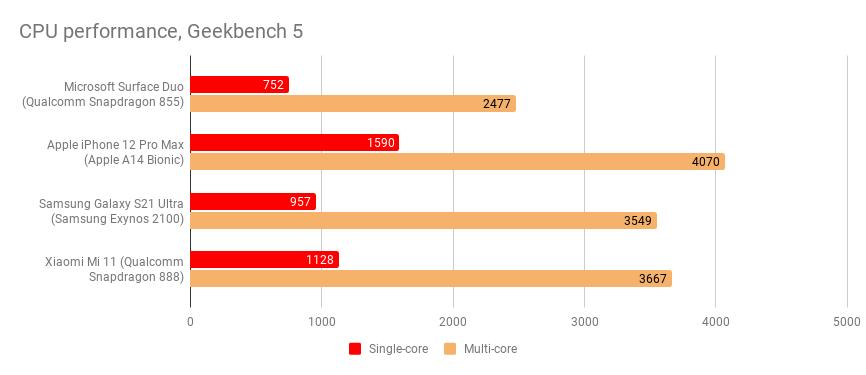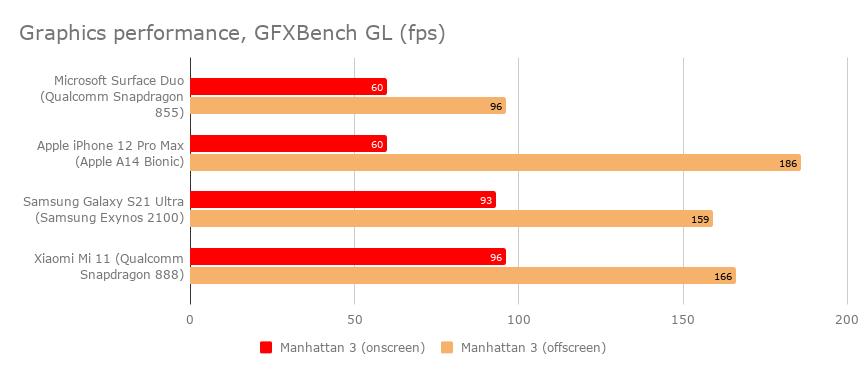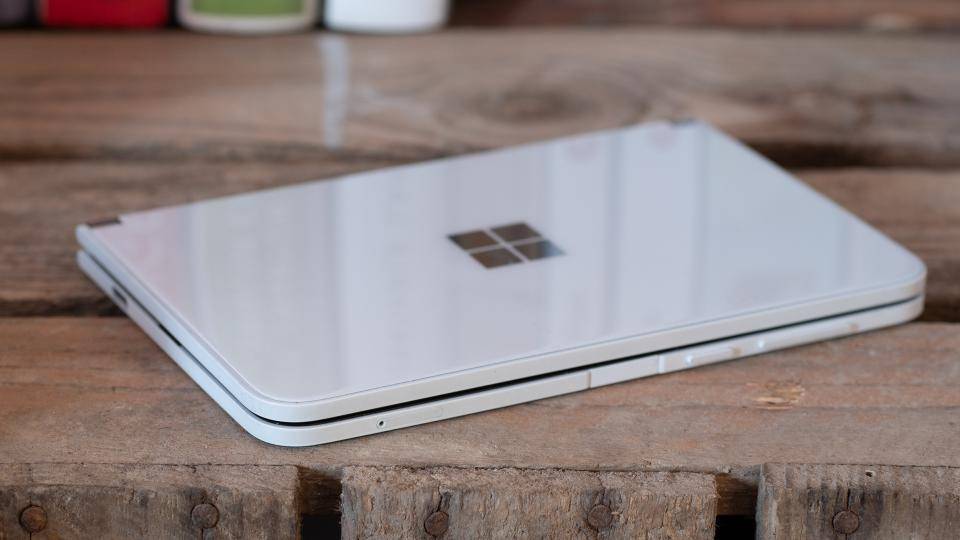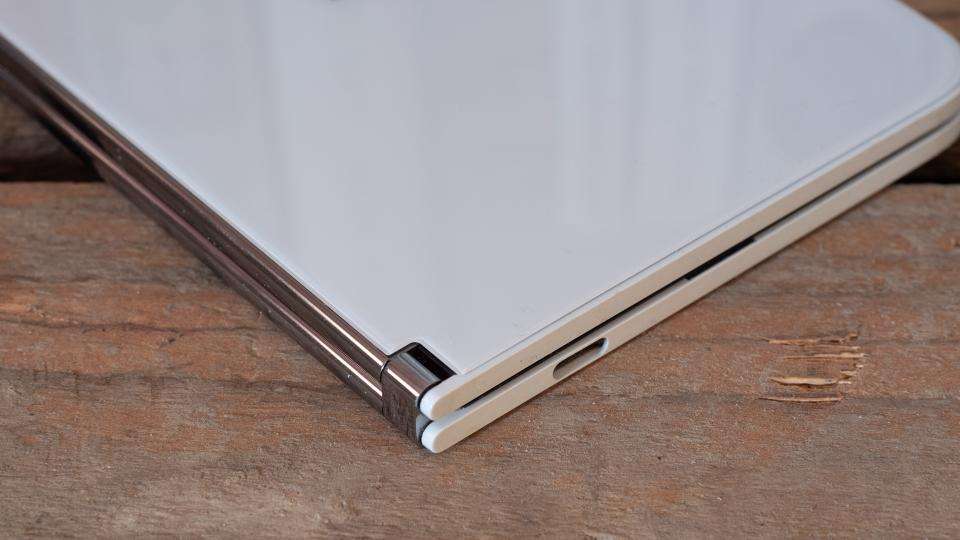Folding tablets – or are they expanding smartphones? – are a 2020 phenomena. Some manufacturers achieve the near miracle of bending the screen itself; others are looking at the seemingly easier task of connecting two screens with a hinge.
The Surface Duo is an example of the latter approach, trading off the complexity of bending an OLED panel for an intriguing design that actively promotes dual-screen operation.
The intrigue doesn’t stop with the hinge and screen. This is a Microsoft device running a Microsoft-badged version of Android 10. The mere concept of which is enough to make your head spin.
But here it is, and applause all round because this is the pragmatic solution to a perennial problem: Microsoft gains a gigantic app base, customers understand what they’re using, and Microsoft can help steer the design of two-screen support on Android.
Its efforts are already visible here, with Microsoft adding its own tweaks and user interface controls with the aim of making life easier for us humble users. This, as we shall see, is both a blessing and a curse.
Microsoft Surface Duo review: Second opinion
-Jonathan Bray-
The Surface Duo has finally arrived in the UK. And now that customers have the privilege of being able to spend £1,349 on Microsoft’s dual-screen smartphone, I’ve taken a second look to see how it stacks up against the competition.
And, after using the phone for around a week and a half, I find myself in agreement with Mr Honeyball, whose original review you’ll find in full below . The Microsoft Surface Duo has been beautifully and painstakingly constructed. Its two separate screens, each sandwiched between slim slabs of rectangular glass and connected – like a 2-in-1 laptop – with 360-degree hinges, are innovative and intelligently engineered.
READ NEXT: These are the best smartphones to buy today
Microsoft has clearly worked hard to make the twin screens work together in sensible ways. Open the Surface Duo up like a book and the default mode is to have two apps open side by side, or one app and the desktop or settings screen next to each other.
Drag an app over the central divider between two screens and you can use the Duo as an 8.1in tablet. Buy the Surface Duo from Microsoft If you want to pop the phone down on a desk or table, meanwhile, you can use it like a tiny laptop, a touch keyboard sprouting automatically onto the bottom display, leaving the top “laptop” screen open for browsing and editing.
It’s so surprisingly effective that I wonder why other manufacturers haven’t simply ditched the problematic flexible display tech of other folding phones in favour of dual-screen tech like this.
Microsoft Surface Duo review: The camera
Alas, for every feature I like about the Surface Duo, there are more that I dislike. The first concerns the camera. I’m not sure what Microsoft was thinking here, because putting only one camera on a smartphone, no matter how revolutionary, is a terrible decision.
The Duo has no wide-angle camera and no telephoto zoom, things many mid-range and even budget phones have these days, let alone handsets costing north of £1,000. You don’t even get a dedicated selfie camera, although that’s actually not such a bad thing as the main camera turns into a selfie camera when you spin it around to face you.
This wouldn’t be such a problem if the 11MP f/2 camera was competent. Unfortunately, it’s terrible. In bright sunshine you can occasionally get a decent shot out of Surface Duo’s camera (see the blossom shot immediately below). However, the vast majority of photographs looked washed out and had an unnatural magenta colour cast.
For context, here are a few comparisons with another £1,300 smartphone, the iPhone 12 Pro Max. You’ll see, there’s absolutely no comparison:
Low light photography is, essentially, a bust. Without the flash turned on, you get noisy, muddy and dark images without fail. The long and short of it is that this simply isn’t good enough for such an expensive device. Everyone deserves a halfway decent camera in their phone, whether it be a £200 budget handset or a £1,300 premium device like this.
Microsoft Surface Duo review: The performance
The other big thing I dislike about the Surface Duo is its general level of performance. In my time with it, it felt generally sluggish and unresponsive to use. Switching displays feels erratic and unpredictable. In folded mode, you double-tap to switch the active display from one side to the other but it frequently took two or more attempts to get this to work.
Swiping up from the bottom of the display to bring up the recent apps view doesn’t work reliably enough, on-screen animations generally felt less than fluid and the shutter in the camera app would regularly stick, taking a second or so before emitting the “clack” to confirm the capture of a photograph.


You could blame the use of a two-year-old SoC here – the generation-old Snapdragon 855 – or the fact that it’s driving two 800 x 1,350 AMOLED displays (for a total 1,800 x 2,700 pixels), but that would be giving Microsoft a free ride. This is a processor that we’ve seen perfectly happily driving phones with screens of roughly equivalent resolutions with no trouble at all.
Again, it’s not good enough. Not by a long shot.
Microsoft Surface Duo review: Other shortcomings
These two major flaws are accompanied by a host of other smaller shortcomings. The phone has no IP rating for water and dust resistance, no storage expansion, and lacks a high refresh rate display. Unforgivably, there’s no NFC, but there’s also no 3.5mm audio jack, no wireless or fast charging and no 5G or Wi-Fi 6.
None of these things is reason alone to completely avoid the Microsoft Surface Duo, as Mr Honeyball points out below. Other devices have weaknesses or omissions similar to these. However, take them all together, then throw in the dreadful camera and weak performance, and they’re enough to seriously undermine the Surface Duo’s case as a phone you should spend more than £800 on, let alone the £1,349 being asked for the model with 8GB of RAM and 128GB of storage.
That’s a shame because I, for one, am intrigued by the idea of the folding, twin-screen smartphone and appreciate having the ability to fit a tablet in my pocket. I’m also impressed with the way Microsoft has developed the software to adapt to this new paradigm.
But, for me, there’s just too much that's wrong here to justify taking a punt on a Surface Duo. Maybe next time (if there even is a next time) Microsoft will get it right.
Jon Honeyball’s full review continues below
What you need to know
After a few months delay, the Duo is finally available to buy in the UK; and it isn't cheap. You'll be paying £1,349 for the version with 8GB of RAM and 128GB of storage, or £1,449 for the variant with 16GB of RAM and 256GB of storage.
For that sort of cash you'd expect nothing less than superlative build quality and, indeed, that is what the Surface Duo delivers. The hinge design is a masterstroke, with a fluid and easy action with just the right amount of friction. The screens are essentially “inside only” for most operations: you open the Duo like a book. If the device is closed, there’s no visible screen. However, you can bend the screens back on themselves to create a normal smartphone-style screen, with the second screen paused on the rear. This is how you operate the device up against your head if you want to make a phone call in the “normal” way.

However, I strongly suggest you don’t bother and switch to a hands-free Bluetooth connection as this isn’t a phone to be held to your head. The only time this orientation makes sense is to take a photo. There’s a single front-facing camera above the right-hand screen, and when you fold the screens back you can point the camera towards the object and view the image on the screen facing you. Which is all lovely, except that the camera performance is so weak compared to rival top-end phones as to be laughable.
One decision Microsoft definitely got right is to heavily invest in the screens, which are both excellent examples of their type. A peak brightness of 624cd/m² is about as good as it gets and they’re tuned to the DCI-P3 colour space, where they cover around 91%. Colour accuracy is good rather than great, with an average Delta E of 3.34. Considering how thin this device is when unfolded, I was pleasantly surprised by the sound quality – but headphones over Bluetooth will be essential for serious listening.
After a couple of weeks, I was starting to question if Microsoft had made the right decision in having a full 360° hinge: I would be quite happy if the hinge was only 180°.
READ NEXT: Everything we know about the Surface Neo
What's it like to use?
But all this serves as an hors d’oeuvre to the main course: what’s the Duo actually like to use? Before tucking in, we need to acknowledge that the Duo is a solution to a set of problems that few others have acknowledged. We all like our big smartphones, but even large single-screen devices make it hard to work on two things at once – consider a mundane task such as looking up a restaurant address and then entering the address into Waze. It’s easier on a tablet, especially one that supports split-screen mode, but one thing you’ll notice about an iPad is that after you fold it in two it doesn’t work so well.

As such, it’s the two-screen, two-task operation mode where the Duo excels. All the Microsoft apps have been updated for the Duo – to genuinely useful effect. For example, Outlook in split screen is almost like the desktop experience: the inbox sits on one side, the message view on the other. This allows me to plough through a full inbox at a considerably faster speed than I can manage on Outlook on an iPhone.
I particularly like having Outlook open on one side with Word or Excel on the other, allowing me to make notes from an email. I even found it productive to simply stretch a larger Excel spreadsheet across both screens.
The usefulness isn’t restricted to apps that have been redesigned for twin-screen use. I found it just as handy when reading a PDF instruction document, as I could then send instructions over a messenger app. Or a messenger app and a map. You get the gist. It has truly surprised me how often this works well and how different it is when performing such tasks on my iPhone 11 Pro Max : there, I move to a laptop or large tablet when performing such tasks. With the Duo, this isn’t necessary.
Some third parties are getting into the act too, with Kindle on two screens a very lovely arrangement. The screens are a high enough resolution to be easily read, the page turn operation is a delight and I find having two pages open at once useful.
The challenge for Microsoft – and Google – is that apps must be optimised to make best use of the twin-screen. The “hole in the middle” can be an issue for an app that isn’t aware of the hinge, and it’s possible to lose a village on a map if it falls down the gap. However, Microsoft is pushing its gestures and twin-screen support back into the Android stack, and Google has committed to working with these tools to enable better developer support.
The gestures themselves aren’t particularly obvious at first use. Whilst this might seem like a criticism, the same comment can be made about Samsung’s split-screen capabilities or those of the iPad Pro : each does things its own way and there’s a learning curve. Once I discovered how the gestures worked, I had no issues. It’s possible to switch the UI away from gesture control to the more standard Android buttons, but I’m convinced this would be a backwards step.
A final use for the second screen is to act as a keyboard for the first, simply by rotating the device 90 ̊. This works effectively and it’s an option I’ve used on a number of occasions to great effect. I was far less enamoured when I tried to use the Surface Pen with this device: it’s supported, but the screen size doesn’t lend itself well to stylus operation, especially compared to a larger tablet.
Buy now from Microsoft
How does it compare to competitors?
Given the robust pricing, it’s not unreasonable to expect that the Duo should do everything, and do it to a world-class level. There’s fierce competition in the four-figure phone market, and it’s imperative to get real value from such a device.
A glance at the spec sheet puts the Duo at a significant disadvantage compared with devices such as the folding phones from Samsung and Huawei , or more conventional devices such as the iPhone 12 .
It would be easy to write off the product – to argue that it’s too little, too late, or that it’s a curiosity that doesn’t have a future. The CPU is more than adequate but was released last year. The Wi-Fi is 802.11ac, rather than Wi-Fi 6 (802.11ax). It supports 4G, not 5G. There’s neither NFC nor Qi charging. Most of this is down to the Surface Duo’s tortuous development journey, with the move to Android only taking place a year ago after the Windows development effort failed.
The other negative is battery life, with a 3,770mAh battery smaller in capacity than rival flagships. Its result of 17hrs 49mins in our video-rundown test isn't a complete disaster but note that was with the video running on one screen and a blank screen on the other. You’ll still get through a working day – I found that it lasted for ten hours of active use across a day– but you’ll be reaching for the USB-C cable every night.
From a tickbox comparison perspective, then, the Duo starts from a position of weakness, but I think this would entirely miss the point. The question is whether you’ll truly miss any of the features not found in the Duo, and if that is likely to change in the next two to three years (the likely active life of this phone). So let’s go through them, one by one.
Wi-Fi 6 is nice to have but surely not essential. What will you be doing on this device that requires such a high-bandwidth connection? 5G is a similar story, especially as we’re stuck with sub-6GHz rather than mmWave in Europe. I admit that wireless charging would be useful, but surely you can live with a cable for a little longer? Arguably the biggest missing feature is NFC, and with it wireless payments, although these tasks are carried out more and more by the smartwatch.
The reality is that smartwatches are now becoming good enough to be your primary device. I certainly do more during the day with my Apple Watch Series 5 than I do with my iPhone. I’m not saying that the iPhone is now irrelevant, but my focus of attention is moving to my watch.
Given that move, it could be argued that it’s time to re-evaluate the role of the smartphone in our daily lives. If notifications, health, messaging, mapping directions and so forth have successfully moved to the watch – and in the case of Apple Watch, they have – the smartphone can be considered a more specific and focused device, rather than the go-to do-everything device of the past decade.
One significant operational change is the sheer delight of closing the screens. Like finishing a book, it allows me to move my focus and attention away from the device. An external-facing screen simply entices you to keep looking, to spot the message and information updates that flow into our devices. Curating these through my watch avoids the socially awkward interference of picking up my phone.
This is Microsoft’s underlying problem: it has the vision, but it doesn’t have all of the components. The combination of an Apple Watch and Surface Duo would be superb, if you could cope with losing the high-quality cameras. But such a combination simply doesn’t work today, and I doubt it’s in Apple’s interest to make it happen with Android devices, either. Nor is there any sign of a leading-edge Android smartwatch from Microsoft – or anyone else. My inelegant solution? I like the Duo sufficiently that I carry it with me, alongside my iPhone.
I’m really looking forward to Microsoft providing updates such as Android 11 – it ships with Android 10 and has committed to three years of support with monthly updates – as well as to seeing how the developer community embraces twin-screen operation. If they don’t, a current standard app works just fine running on one screen, and might work well stretched across both.
For this, I have to applaud Microsoft in its efforts. If you treat it as a weird smartphone then it will make absolutely no sense and, by any logical criteria, will fail compared to a leading modern smartphone from Apple, Samsung or a competitor. But if you get inside the mindset of what Microsoft is trying to accomplish here, there’s much to learn. With the Duo, the company has been brave enough to ask the questions that others are not daring to consider. And to those who say “you would get all this with a tablet”, that may be, but we come back to the key point: it wouldn’t fit into your pocket.
Buy now from Microsoft
Should you buy one (if you could)?
I ordered the Surface Duo simply to be able to have “Android by Microsoft”, to satisfy that inner, extremely childish urge to scream “I told you so!” at the Steve Ballmer-era Microsoft management. I wasn’t expecting it to make me sit back and reconsider the smartphone as a device, its relationship to the evolving world of smartwatches, and to ask all those questions about operational use, social pleasantries and our reliance on this technology.
If these things give you pause for thought, the Surface Duo is absolutely right for you. If you would like to do more on a pocket-friendly device than a smartphone can deliver, the Duo is worth purchasing – although I’d still wait for an updated version in the hope of a better camera. I just hope that Microsoft has the determination to push forward with this concept and doesn’t abandon it as a mistake.
|
Microsoft Surface Duo - Specifications |
|
Processor |
Qualcomm Snapdragon 855 |
|
Storage |
128GB/256GB |
|
RAM |
6GB |
|
Displays |
2 x 5.6in 1,350 x 1,800 AMOLED |
|
Camera |
11-megapixel |
|
Battery |
3,577mAh |
|
Dimensions |
|
|
Weight |
250g |

